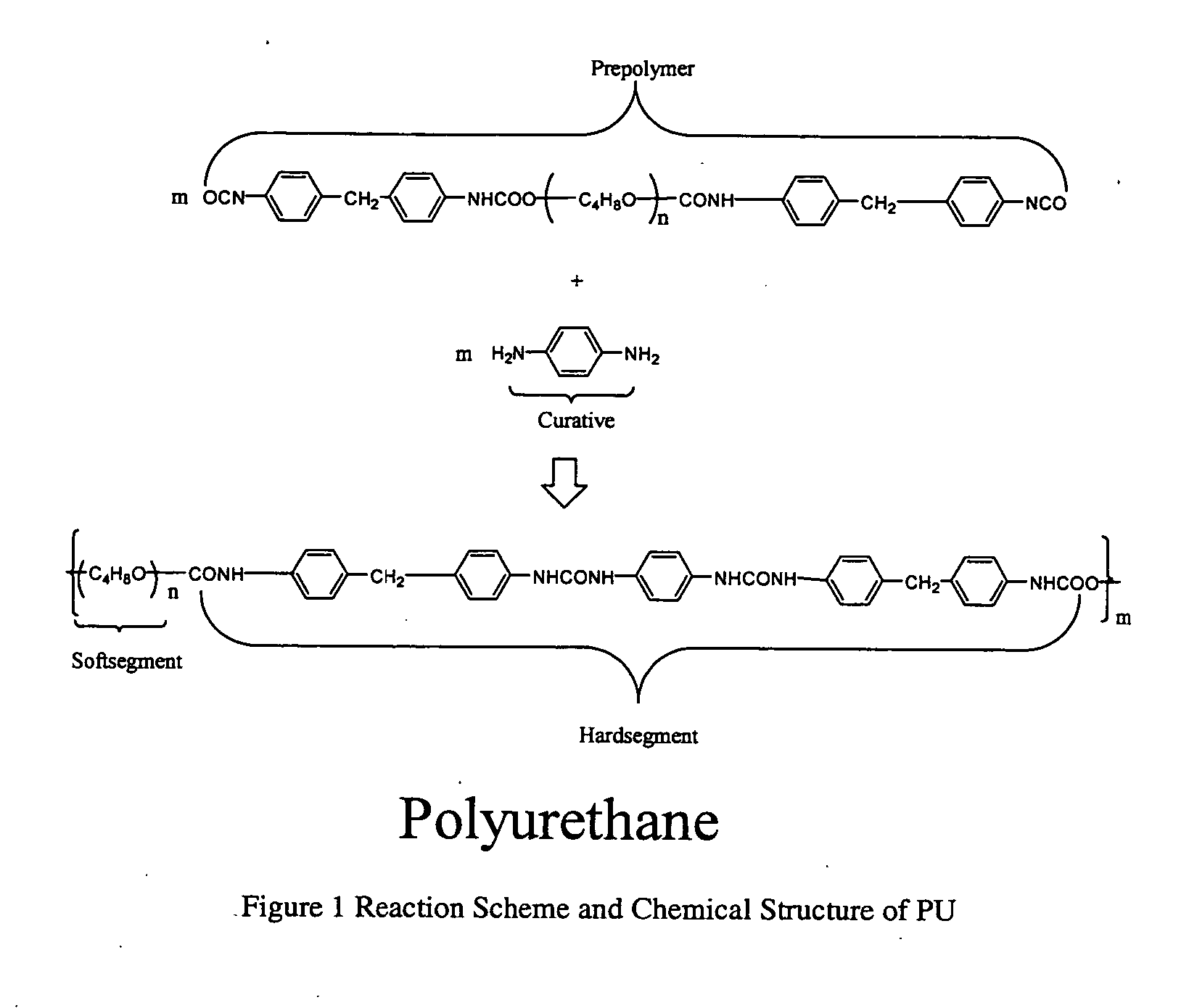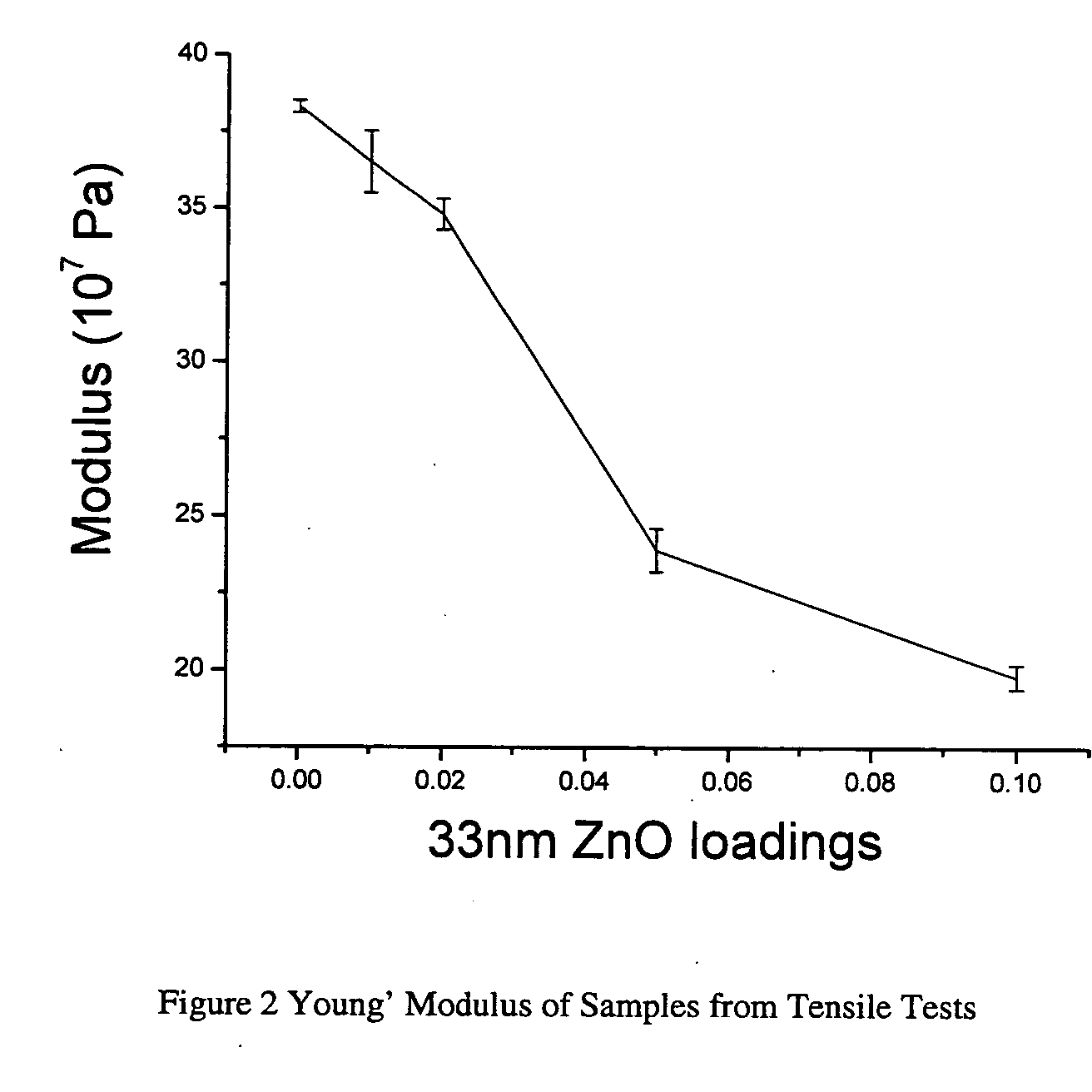Block copolymer and nanofiller composites
a composite material and copolymer technology, applied in the field of polymer nanocomposites, can solve the problems of cost and customer special requirements, and the traditional method is difficult to meet the needs of customers
- Summary
- Abstract
- Description
- Claims
- Application Information
AI Technical Summary
Benefits of technology
Problems solved by technology
Method used
Image
Examples
example 1
[0061] Typical procedure for composites: Equal molar ratio of a degassed PU prepolymer (TDI-PPG Prepolymer; wt % NCO is 6.32; Airthane® PPT-95A Prepolymer; Air Products) and a diamine curative (aromatic diamine; Lonzacures MCDEA Curative; Air Products) were dissolved in purified THF to form 15% solution at 25° C. ZnO particles (used as received; nano-size=33 nm; Nanophase Technologies Corporation; micron-size=˜2.5 μm; Atlantic Equipment Engineers) were dispersed in THF to form a 10% solution with a sonicator-solutions that contain 10-20% ZnO may also be used. The two solutions were combined together and sonicated for 20 min in ice / water bath. Subsequently the mixture was concentrated to 60% solution. The solution was cast into moulds and cured at 40° C. for 8 h, and then cured at 110° C. for 24 h to form thin films with different thickness from 0.2 to 1 mm. The preparation of neat PU uses a similar procedures.
[0062] In general, the common preparation procedure of...
example 2
DMTA and Tensile Tests
[0064] The mechanical responses of samples were measured with a DMTA (DMTA V, Rheometric Scientific) and Instron 8562. Two kinds of DMTA measurements were performed: 1, Dynamic (1 Hz, 6.2832 Rad / s) strain sweep at room temperature (21° C.); 2, Dynamic (1 Hz, 6.2832 Rad / s) temperature ramp sweep at 0.1% strain and 2° C. / min rate from −130° C. to 200° C. Tensile tests were performed to give the Young's Modulus and elongation of samples. Each data point is averaged from 3-6 samples.
[0065]FIG. 2 is the Young's Modulus of the neat PU and its composites with different ZnO nanoparticles loadings from tensile tests. FIG. 3 is the storage modulus vs. strain for samples from DMTA tests. All these tests were performed at around 21° C. All detailed DMTA and tensile tests data are listed in Table 1.
TABLE 1Data from Tensile Tests and DMTA TestsStorageYoung'TgModulusModulusElongationMaterial(0° C.)(107 Pa; 0.1%)(107 Pa)(%)PU2.919.638.3 ± 0.2492 ± 98 1 wt % 33 nm ZnO017.63...
example 3
AFM Measurements
[0070] The AFM (Autoprobe CP; Park Scientific Instruments; with tip, ultralevel D; spring constant ˜18N / m; and MultiMode Scanning Probe Microscope; Digital Instruments) measurements were conducted at room temperature using the tapping mode with different forces. The samples were neat PU and the composite with 5 wt % 33 nm ZnO in films of (1) 500 μm thickness and (2) less than 1 μm (10 wt % THF solutions were spin coated at 3000 rpm) on silicon wafers.
[0071] AFM was used to determine the microstructures of PU and composites. Until now real space characterization of the phase-separated morphology in PU is still a challenging task. Transmission electron microscopy (TEM) studies on stained films have yielded some insight, but the experiments are limited by the efficacy of the staining, the kind of the PU and the possibility of the electron beam damage. In recent years, atomic force microscopy (AFM) has been used to image the microdomains in the PUs. In PUs, the mechani...
PUM
| Property | Measurement | Unit |
|---|---|---|
| Tg | aaaaa | aaaaa |
| Tg | aaaaa | aaaaa |
| image size | aaaaa | aaaaa |
Abstract
Description
Claims
Application Information
 Login to View More
Login to View More - R&D
- Intellectual Property
- Life Sciences
- Materials
- Tech Scout
- Unparalleled Data Quality
- Higher Quality Content
- 60% Fewer Hallucinations
Browse by: Latest US Patents, China's latest patents, Technical Efficacy Thesaurus, Application Domain, Technology Topic, Popular Technical Reports.
© 2025 PatSnap. All rights reserved.Legal|Privacy policy|Modern Slavery Act Transparency Statement|Sitemap|About US| Contact US: help@patsnap.com



